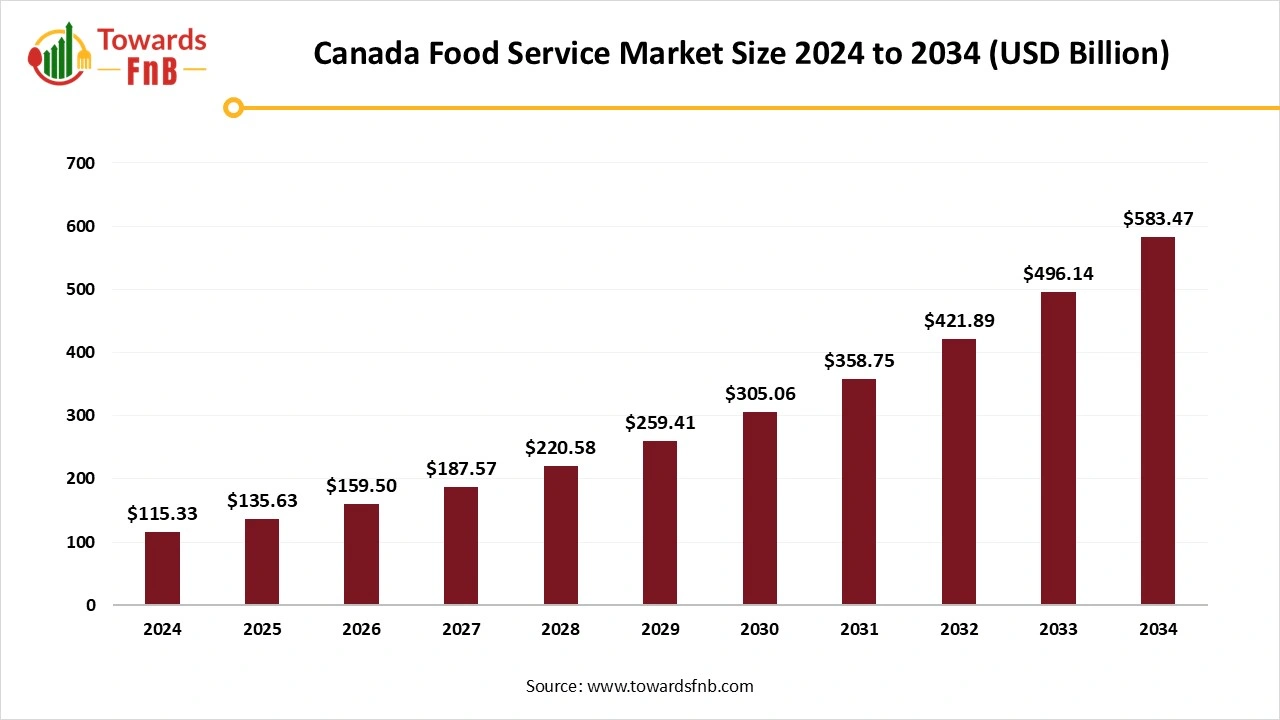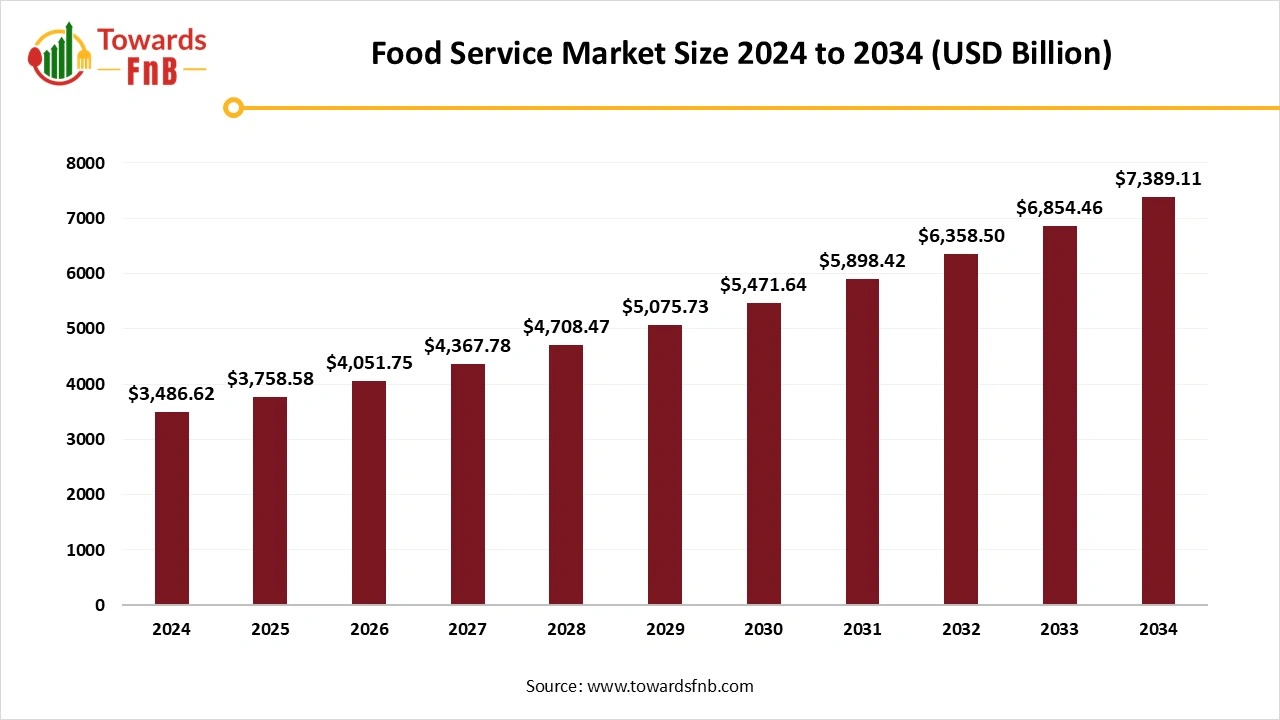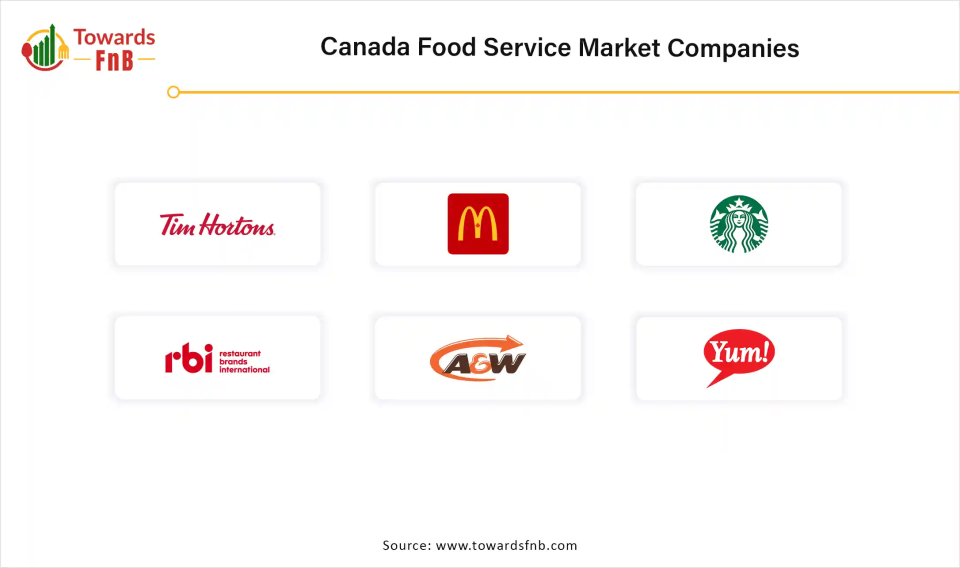December 2025
The Canada food service market size was valued at USD 115.33 billion in 2024 and is expected to grow steadily from USD 135.63 billion in 2025 to reach nearly USD 583.47 billion by 2034, with a CAGR of 17.6% during the forecast period from 2025 to 2034. Rising spending on the food, changing food habits of consumers and diverse food services driving the service market.

| Study Coverage | Details |
| Growth Rate from 2025 to 2034 | CAGR of 17.6% |
| Market Size in 2025 | USD 135.63 Billion |
| Market Size in 2026 | USD 159.50 Billion |
| Market Size by 2034 | USD 583.47 Billion |
| Base Year | 2024 |
| Forecast Period | 2025 to 2034 |
The Canada food service market encompasses the full range of businesses that prepare, serve, and sell food and beverages to consumers outside the home. This includes restaurants, cafes, quick-service outlets, institutional catering, and delivery services. The market is influenced by evolving consumer preferences, urbanization, lifestyle changes, and increasing demand for convenience and variety.
The sector is seeing strong recovery post-pandemic, with digital innovation, sustainability initiatives, and rising demand for health-conscious and culturally diverse offerings playing a pivotal role. Labor shortages, food inflation, and changing regulations around packaging and nutrition disclosure also impact the market landscape.
In Canada, the advancements promise considerable benefits for the restaurant industry.
AI in Canadian restaurants has the potential to change business operations, improving customer interactions and streamlining back-of-house processes. By adopting restaurant technology trends and utilizing sophisticated restaurant management software, Canadian establishments can maintain a competitive edge, providing distinctive and efficient services that meet the contemporary diner's demands. Utilizing AI and machine learning, restaurant management software in Canada can provide tailored dining experiences and enhance restaurant automation nationwide.
Restaurant Industry in Canada
Daily, countless Canadians eat out, supporting a vibrant network of dining establishments from one coast to the other. These eateries do more than serve food; they are economic giants, generating substantial jobs and tax income. Their investments resonate across the economy, enhancing growth and cultivating a strong, interconnected economic structure. Fundamentally, Canada's restaurant sector exemplifies how communal dining influences economic strength. Over 100,000 dining establishments throughout Canada. The restaurant sector creates 17.6 new jobs for each million dollars in output. In contrast, the industrial average stands at 7.4 jobs for every million dollars generated.
Restaurants throughout Canada have been broadening their plant-based menus, emphasizing innovative and tasty dishes to appeal to this expanding group of customers. As virtual experiences gained popularity during the pandemic, restaurants and food service venues have been looking into virtual cooking classes, food tastings, and hybrid events that merge in-person and online components to connect with a broader audience.
Menu innovation and personalization have emerged as key differentiators in the market as restaurants respond to evolving consumer tastes. The sector has experienced a surge of global cuisines, blended concepts, and focused dietary choices. This shift in menu options demonstrates the industry's adaptability to evolving consumer tastes and dietary needs, while simultaneously creating fresh chances for market distinction and expansion in the foodservice industry.
Increasing operating expenses, such as costs for rent, sourcing food, equipment, and utilities, consistently challenge businesses in the food service industry. These rising expenses frequently pressure profit margins, particularly for smaller restaurants and independent food establishments. Furthermore, the heightened competition and consumer price sensitivity create pressure to uphold competitive pricing while also ensuring quality and profitability, complicating the ability to sustainably manage cost pressures without sacrificing food quality or service.
The global food service market was valued at USD 3,486.62 billion in 2024 and is projected to increase from USD 3,758.58 billion in 2025 to approximately USD 7,389.11 billion by 2034. This represents a compound annual growth rate (CAGR) of 7.8% from 2025 to 2034. The market includes all establishments that prepare and serve food and beverages outside the home such as full-service restaurants, cafés, cloud kitchens, and institutional catering services. Growth is being driven by expanding urban populations, shifting consumer lifestyles, and rapid digital advancements, all of which continue to reshape the global food service landscape.

Which Type of Foodservice Dominates the Canada Food Service Market in 2024?
Quick service restaurants segment led the Canada food service market in 2024. The market is driven by elements such as the inclination towards fast food, a rise in eating out, and the growth of convenience consumption, particularly in the morning. Furthermore, the enhancement in consumer lifestyles and the expanding workforce has boosted the demand for fast food through quick-service restaurants. The Canadian quick-service restaurant (QSR) sector goes under the major transformation, with independent and smaller chains businesses rising as important contributors to innovation and growth. The emergence of smaller QSR chains and independent establishments indicates a wider change in consumer habits and market forces. With Gen Z and diverse communities at the forefront, the foodservice sector is primed for change.
Cloud Kitchens & Fast Casual Segment is Observed to Grow at the Fastest Rate During the Forecast Period.
With the increasing demand for convenience and on-demand services, cloud kitchens have become a crucial answer to fulfill these requirements. These resources enable companies to function with lower operating expenses, optimize delivery procedures, and accommodate a broad range of customer tastes. The growth of mobile applications and internet ordering systems has established a strong foundation for cloud kitchens to flourish, improving their availability and presence.
Which Cuisine Type Held the Dominating Share of the Canada Food Service Market in 2024?
North American segment held the dominating share of the Canada food service market in 2024. The demand for North American cuisine is influenced by several factors, such as convenience, cost-effectiveness, and a rich variety of foods stemming from immigration and regional differences. North American food features barbecue, milkshakes, and a variety of fried dishes. Numerous classic American meals are distinctive interpretations of foods that originated from various other culinary cultures, such as hot dogs, pizza, and Tex-Mex. The United States is a country comprised of immigrants, leading to a diverse range of culinary traditions. American cuisine is not a single, uniform concept but a mixture of diverse traditions, including Native American staples and recipes introduced by immigrants from Europe, Asia, and Latin America.
Asian & Plant-Based Cuisine Segment is Expected to Grow at the Fastest Rate in the Market During the Forecast Period.
A major factor contributing to the Asian cuisine popularity is the enhancing admiration for genuine ethnic tastes. Asian fusion cuisine presents chefs with a broad spectrum of flavors, allowing for creative expression in crafting unforgettable dishes with innovative flavor pairings, while food lovers embrace the variety and cultural interactions. The increased interest in healthier food choices has boosted the popularity of Asian cuisine, as the prevalent Asian dietary practices are plant-based. Numerous Asian cuisines are recognized for prioritizing fresh and nutritious ingredients, and plant-based options are swiftly becoming a favorite.
Which Channel Dominated the Canada Food Service Market with the Largest Share in 2024?
Dine-in segment dominated the market with the largest Canada food service market share in 2024. Currently, consumers enjoy an unparalleled selection of dining choices, ranging from fast food places to high-end restaurants. As a result, customer expectations for restaurant offerings are consistently increasing, and they are now more discerning in choosing better dining options based on the advantages they anticipate from their choices. The urge to eat out can arise from multiple factors, such as the desire for quick meals, celebrating important occasions, hosting business associates, and others. Restaurant proprietors often allocate significant resources to marketing initiatives to attract customers, utilizing diverse strategies ranging from menu layout to special promotions.
Online Delivery & Aggregator Platforms Segment Expects the a Notable Growth During the Forecast Period.
Increasing need for food delivery, driven by individuals' busy lifestyles, is stimulating market expansion. Additionally, food delivery services save time and are advantageous for busy individuals who have little time to prepare meals, fostering the growth of the target market. The emergence of appealing, user-friendly applications and tech-based driver networks, combined with changing consumer needs, has established ready-to-eat food delivery as a prominent market segment. In Canada, food service companies use aggregator platforms such as DoorDash, Uber Eats, and SkipTheDishes to connect with customers and handle online orders. These platforms serve as links, uniting restaurants with patrons and managing online ordering and delivery operations.
Why Chain Outlets Segment Held the Largest Share of the Canada Food Service Market in 2024?
Chain outlets segment held the largest share of the market in 2024. A major factor driving segment growth is the rising urbanization and changing consumer habits, which prefer fast and conveniently available meals. The rapid tempo of contemporary life has resulted in increased reliance on fast food and QSR brands, especially among working individuals and younger demographics. Growing a restaurant chain enables you to provide consistent products and services for customers who depend on your brand. Operating multiple locations facilitates the standardization of recipes and food, guaranteeing a uniform menu.
Independent Ethnic Restaurants Segment is Observed to Grow at the Fastest CAGR During the Forecast Period.
The need for independent ethnic eateries is increasing, fueled by a heightened interest in varied culinary experiences and a desire for genuine, culturally enriching meals. This trend is driven by elements like globalization, heightened travel, and a craving for distinctive and unforgettable dining experiences. The achievement of independent restaurants is due to their capacity to present specialized menus, uphold high-quality standards, and deliver distinctive dining experiences. These venues frequently hire expert chefs and well-trained personnel to provide exceptional dining experiences and unique menu offerings.
A&W and Ruffles
Bondi Produce and Gordon Food Service
Botaneco and Lovingly Made Flour Mills
Happy Belly Food Group

By Type of Food Service
By Cuisine Type
By Distribution Channel
By Ownership
December 2025
December 2025
December 2025
December 2025